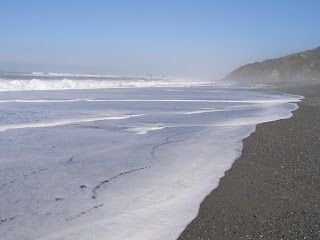
Thursday morning, the first day of November, started off cool and foggy. Overcast, steely gray skies and low fog hinted at a long, dark Humboldt wintery kind of day. Though the forecast called for clearer skies by lunchtime, there was nothing in the air at the beach to raise the hope of anything approaching of blue and clear.
Then, at precisely 10am, as if on schedule, the flat silver curtain lifts and the world opens up around us. Gray turns white that slides into pale blue. A wispy mist hangs high above us reflecting the new-found sun creating a bright glare and squints my unprotected eyes.
The surf is high today. The waves running farther in and out than has been usual. In fact, I can count 7 or maybe 8 sets of cresting and running waves in the first quarter mile or so offshore. The roar of whitewater surrounds me as I walk the wet sand at the surf line.
There is no even wave line this morning. Several times, waves chase me and my government-issue cordovan boots back up the slope. It's a classic, sneaker wave kind of day , each wave deciding where it's own journey ends.
Every surge of ocean leaves behind a curving line of thick white foam, carbonated sea water churned and agitated by their long runs. The low angled winter sun creates mini-rainbows in the foamy bubbles.


A collage of multicolored pebbles flushed from the creek into sea, are pushed back to dry ground, their weight finally halting their return voyage below the tide line.


There is so much motion at water's edge this morning it's almost disorienting, as if I can feel the movement of the water, the movement of the earth.
A large flock of gulls - almost exclusively western gulls today - gather at the crest and ocean-side slopes of the beach near the mouth of the creek. Higher moving waves scatter the gulls in squawking gaggles that circle and return to the very same vulnerable spots moments later.

The combination of low tide and a few days without rain have narrowed Redwood Creek's channel into the Pacific. The force of downhill-moving freshwater into the onrushing saltwater waves creates a cup, a "C"-shaped bend in the powerful surf. Though the force behind the ocean's waves travel thousands before meeting higher ground, the relatively short, 67-mile gravitational force wins the day in this spot. Even though occasional strong wave will override the open channel and send its saline waters deeper into the estuary, dislodging the small group of bathing gulls, the salt water eventually ebbs and the ever-driving river channel is revealed again.
In the middle, where ocean and creek collide, swirling eddies and erratic white splashes send lines of water in all directions. The push and pull of the Pacific and the creek's rainwater continues as it has for eons. Two seals bob in and out within the tumultuous transition zone, watching me, happily fishing (or maybe just playing) in the swirling waters.



As the tide rises, large waves enter the channel more frequently, overrunning the creek's force. The mouth slowly widens. I hear the honking of Canada geese from the southern backwaters of the estuary, enjoying a rest from their long southerly journey. A few pelicans cruise past, surfing the air currents just above the breaking waves. A lone cormorant joins the seals at the mouth, ducking beneath the running white foam of each incoming wave.




No comments:
Post a Comment